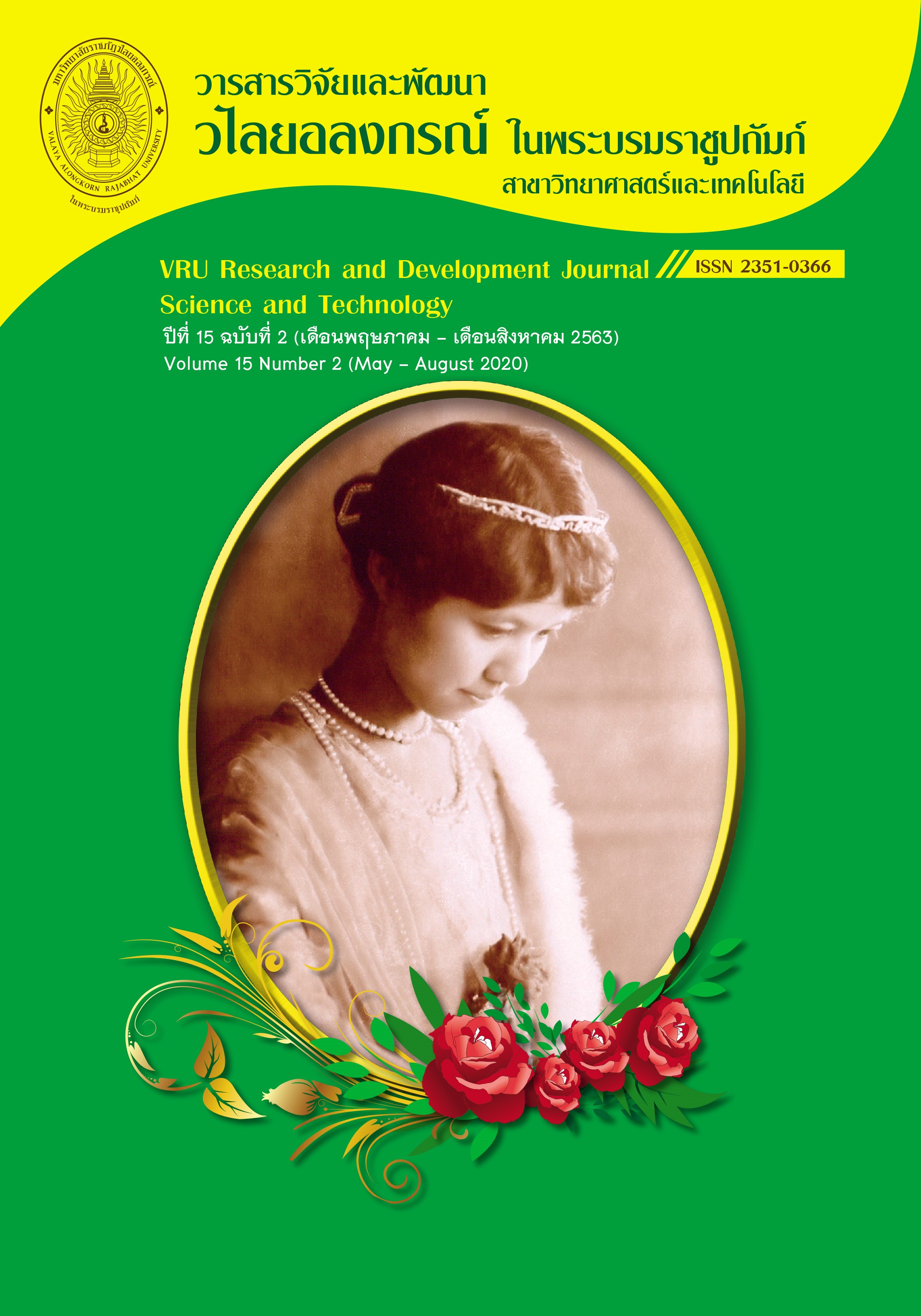DEVELOPMENT OF PRODUCTION PROCESS AND SHELF-LIFE EXTENSION OF COOKED STICKY RICE IN BAMBOO SHOOT CUT (KAO LAM) IN AMPHUR MUANG, NAKHON PATHOM PROVINCE
Main Article Content
Abstract
The objectives of development of production process and shelf-life extension of cooked sticky rice in bamboo shoot cut (Kao Lam) in Amphur Muang, Nakhon Pathom province were to develop the production process to reach Thai Community Product Standard of cooked sticky rice in bamboo shoot cut (Kao Lam) (TCPS 746/2548) and shelf-life extension by using the proper humectants, packaging and storage temperature. The results showed that the proper production process was hygienic production control such as wear the cap or hair net, apron, mask and glove, preparation or cooking in a clean place at least 60 centimeters above the ground, sterilized coconut milk mixer by heating at 100 degrees celsius for 5 minutes and then rapidly cool down before pouring in cleaned bamboo shoot cut and covering with cleaned and dried banana leave. Studies on shelf-life extension using humectants were elucidated by 2x3 factorial in completely randomized design. The studied factors were employed with two factors: sucrose substituted by glycerol at 2 levels (10 and 15%) and sucrose substituted by sorbitol at 3 levels (20, 30 and 40%). It was found that sucrose substituted by 15% glycerol and 20% sorbitol was the proper humectant for shelf-life extension in the sense of production cost, microbial and sensory quality. In addition, comparative studies on packaging, traditional without vacuum and vacuum packaging, and storage temperature, room temperature and chilled, were investigated. The best method for shelf-life extension of cooked sticky rice in bamboo shoot cut was traditional packaging preserve by chilled. This condition contributing to prolong shelf-life from not over 1 day to be 6 days. The microbial quality had met Thai Community Product Standard with acceptance from panelists and the lowest production cost.
Downloads
Article Details
Copyright Notice
The copyright of research articles published in the VRU Research and Development Journal Science and Technology Journal belongs to the Research and Development Institute, Valaya Alongkorn Rajabhat University under the Royal Patronage. Reproduction of the content, in whole or in part, is prohibited without prior written permission from the university.
Responsibility
The content published in the VRU Research and Development Journal Science and Technology Journal is the sole responsibility of the author(s). The journal does not assume responsibility for errors arising from the printing process.
References
จารุภัทร ลือชา, วรพจน์ ราชการดี, ชวโรจน์ ดำเนินสวัสดิ์, ฐิติศิลป์ กิจชเวงกุล และภาวินี ดีแท้. (2561). การศึกษาหาสูตรที่เหมาะสมเพื่อยืดอายุการเก็บรักษาผลิตภัณฑ์เส้นบะหมี่สด. วารสารเทคโนโลยีการอาหาร มหาวิทยาลัยสยาม, 13(1), 71–83.
ปิยะนุช คันโธ. (2545). การยืดอายุการเก็บรักษาขนมเปี๊ยะโดยการใช้สารลดค่าวอเตอร์แอคติวิตี้และบรรจุภัณฑ์. วิทยานิพนธ์วิทยาศาสตรมหาบัณฑิต คณะอุตสาหกรรมเกษตร, มหาวิทยาลัยเกษตรศาสตร์.
พัชรา ถาวระ. (2561). การพัฒนายกระดับสถานที่ผลิตข้าวหลามในจังหวัดน่านเข้าสู่มาตรฐานการผลิตขั้นต้น. พุทธชินราชเวชสาร, 35(1), 53-64.
พิมพ์เพ็ญ พรเฉลิมพงศ์ และนิธิยา รัตนาปนนท์. (2562ก). Retrogradation / รีโทรเกรเดชัน, 30 มกราคม 2563. http://www.foodnetworksolution.com/wiki/word/0591/retrogradation
พิมพ์เพ็ญ พรเฉลิมพงศ์ และนิธิยา รัตนาปนนท์. (2562ข). Sugar alcohol / น้ำตาลแอลกอฮอล์, 21 ธันวาคม 2562. http://www.foodnetworksolution.com/wiki/word/1628/sugar-alcohol
วชิราภรณ์ สุริยนต์. (2560). การยืดอายุการเก็บรักษากาละแมด้วยแซนแทนกัม ฮิวเมกเตนท์ และสภาวะการเก็บ. วิทยานิพนธ์วิทยาศาสตรมหาบัณฑิต คณะอุตสาหกรรมเกษตร, มหาวิทยาลัยเชียงใหม่.
วราภา มหากาญจนกุล, สิริพร สธนเสาวภาคย์, สุดสาย ตรีวานิช, และปรียา วิบูลย์เศรษฐ์. (2558). การจัดการความปลอดภัยอาหารสำหรับงานบริการอาหาร. (พิมพ์ครั้งที่ 4). กรุงเทพฯ: มหาวิทยาลัยเกษตรศาสตร์.
วรารัตน์ สานนท์, ปิยวรรณ ธรรมบำรุง, เพ็ญพักตร์ แกล้วเดชศรี, วิรัติ จันทรทรัพย์ และศรัณยา จังโส. (2561). อดีตถึงปัจจุบันแนวทางการพัฒนาอาหารท้องถิ่นที่เป็นอัตลักษณ์ของจังหวัดนครปฐม. วารสารวิทยาการจัดการ มหาวิทยาลัยราชภัฏนครปฐม, 5(1), 130-142.
วโรดม ธุววิโรจน์. (2555). การยืดอายุการเก็บรักษาขนมเปียะกุหลาบโดยใช้สารควบคุมความชื้นและบรรจุภัณฑ์. วิทยานิพนธ์วิทยาศาสตรมหาบัณฑิต คณะอุตสาหกรรมเกษตร, สถาบันเทคโนโลยีพระจอมเกล้าเจ้าคุณทหารลาดกระบัง.
วิมลสิริ รุจิภาสพรพงศ์. (2550). การสืบทอดภูมิปัญญาท้องถิ่นและการส่งเสริมเศรษฐกิจชุมชน: กรณีศึกษาการทำข้าวหลามในชุมชนพระงาม จังหวัดนครปฐม. วิทยานิพนธ์ศึกษาศาสตรมหาบัณฑิต คณะศึกษาศาสตร์, มหาวิทยาลัยศิลปากร.
วีรวุฒิ พามี และผจงรักษ์ พันมี. (2561). การศึกษากระบวนการผลิตและสุขลักษณะที่ดีในการผลิตข้าวหลาม. รายงานวิจัยศิลปศาสตรบัณฑิต คณะวิทยาศาสตร์และเทคโนโลยี, มหาวิทยาลัยราชภัฏนครปฐม.
ศิรินทิพย์ แสงสว่าง. (2547). การยืดอายุการเก็บพายไส้เผือกโดยใช้สารคงความชื้นและการปรับสภาพบรรยากาศภายในภาชนะบรรจุ. วิทยานิพนธ์วิทยาศาสตรมหาบัณฑิต คณะวิทยาศาสตร์, จุฬาลงกรณ์มหาวิทยาลัย.
ศุภชัย เนื้อนวลสุวรรณ. (2549). ความปลอดภัยของอาหาร. กรุงเทพฯ: sister print & media group.
สำนักงานมาตรฐานผลิตภัณฑ์อุตสาหกรรม. (2548). มาตรฐานผลิตภัณฑ์ชุมชนข้าวหลาม (มผช. 746/2548), 21 สิงหาคม 2561. http://tcps.tisi.go.th/pub/tcps746_48.pdf
AOAC. (2000). Offical method of analysis. (17th ed.). Virginia: The association of office analytical chemists.
Birkhed, D., Edwardsson, S., Kalfas, S. and Svensater, G. (1984). Cariogenicity of sorbitol. Swedish dental journal, 8, 147-154.
Chirfe, J. and Fontan, C. F. (1980). Prediction of water activity of aqueous solutions in connection with intermediate moisture foods: experimental investigation of the aw lowering behavior of sodium lactate and some related compounds. Journal of food science, 45, 802-804.
Labuza, T. P. and Hyman, C. R. (1998). Moisture migration and control in multi-domain foods. Trends in food science & technology, 9, 47-55.
Singh, H., Lin, J., Huang, W. & Chang, Y. (2012). Influence of amylopectin structure on the rheological and retrogradation properties of waxy rice starches. Journal of cereal science, 56(2), 367-373.
Srirot, K., and Piyachomkwan, K. (2003). Technology of starch. (3th Ed.). Bangkok: Kasetsart University.
Suzuki, A., Tekeda, Y. & Hizukuri, S. (1985). Relationship between the molecular structure and retrogradation properties of tapioca, potato, and kuzu starches. Journal of the japanese society for starch science, 32, 205-212.
Whistler, R. L., and Bemiller, J. N. (1999). Carbohydrate chemistry for food scientist american association of cereal chemists. St. Paul: MN.


